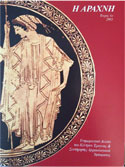August's word: Panathenaea

We are in the month of Hecatombeon. Between the 25th and 28th of the month, took place in Athens the Festival of the Panathenaea.
The Panathenaea was the greatest and most splendid religious-politic festival of the Athenians in honour of “the Goddess”, Athena Polias, the protector of their city. In the festival participated all Athenians with their families, as well as metics, foreigners living in Athens, and representatives of other cities. Their origin must go far back, perhaps to the period of the synoecism, when, according to tradition, Theseus united all settlements of Attica in one polis. (Their end in the 3d c. AD).
The so-called Small or Lesser Panathenaea were celebrated every year, the Great Panathenaea every four years, the third year after the Olympic Games. This is why the Great Panathenaea were also called Πεντετερίς (= every four years).
The festival included poetic competitions and music games at the Odeon (later in the Odeon of Pericles next to the Theater of Dionysus), featuring songs accompanied by the cithara or the flute or without accompaniment, as well as musical performances for cithara or flute or for two flutes. Moreover, different athletic competitions took place, such as running and equestrian games, as well as a boat race, with the corresponding awards. The most famous prize was the richly decorated Panathenaic amphora.
The running games were organised by the agōnothetai or athlothetai, one from each tribe. They are mentioned already since 566 BC according to the following inscription (IG I³ 507) from the Acropolis (at the Epigraphical Museum), in the context of their official instutionalisation by Peisistratos.
[ΤΟ]Ν ΔΡΟΜΟΝ [: ΕΠΟΙΕΣΑΝ : ? ΗΙΕΡΟΠ]-[ΟΙΟΙ : ? ΚΡ]ΑΤΕΣ [: ? ΘΡΑΣ]ΥΚΛΕΣ : Α[Ρ]ΙΣ-ΤΟΔΙQΟΣ : ΒΡ[ΥΣΟΝ :] ΑΝΤΕ[ΝΟΡ ? ][ΗΟΙ ΤΟΝ] ΑΓΟ[ΝΑ ΘΕΣ]ΑΝ ΠΡΟΤΟ[Ι] ΓΛ-ΑΥ[Q]ΟΠΙΔΙ : QOΡ[EI]
“The running game was organised by the magistrates Kratēs, Thrasyklēs, Aristodikos, Brysōn, Atēnōr, who first instituted the competition in honour of the maiden with gleaming eyes (Athena)”.
The culmination of the festival was the formal Great Procession, in which took part the whole population of Attica, and the big feast with the common meal. The most characteristic part of the procession was the offering of the richly decorated saffron-coloured peplos to Athena, depicted in the Parthenon frieze. The peplos was woven, every year, by girls of aristocratic families of Athens, called ergastinai and depicted the Gigantomachy, the fight of the Gods and the Giants. Since the 4th century, during the Great Panathenaea, the peplos was suspended as a sail on the so-called Panathenaic ship, a ship on wheels that was pushed through the city to the Acropolis. The festive sacrifice with a hecatomb (sacrifice of 100 bulls) marked the end of the official ceremony.


